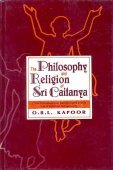Vishishta Advaita, Viśiṣṭa Advaita, Vishishtadvaita, Viśiṣṭādvaita: 7 definitions
Introduction:
Vishishta Advaita means something in Hinduism, Sanskrit, Hindi. If you want to know the exact meaning, history, etymology or English translation of this term then check out the descriptions on this page. Add your comment or reference to a book if you want to contribute to this summary article.
The Sanskrit terms Viśiṣṭa Advaita and Viśiṣṭādvaita can be transliterated into English as Visista Advaita or Vishishta Advaita or Visistadvaita or Vishishtadvaita, using the IAST transliteration scheme (?).
In Hinduism
Vaishnavism (Vaishava dharma)
Source: The Annals of the Research Project Center for the Comparative Study of Logic: A Study of Rāmānuja’s TheologyViśiṣṭādvaita (विशिष्टाद्वैत) or Viśiṣṭādvaitavāda refers to “qualified monisim”, according to Koki Ishimoto in his paper, A Study of Rāmānuja’s Theology : Three Aspects of viśiṣṭatva of Brahman.—Rāmānuja (1017-1137) is known as a philosopher who tried to harmonize the Vedānta philosophy with Vaiṣṇava theology. In later times his theory came to be called viśiṣṭādvaita-vāda ‘qualified monisim’, since, in his view, Brahman is supposed to be qualified by three real factors: specifiers or differentiators (viśeṣa), auspicious qualities (kalyāṇaguṇa), and a twofold body (śarīra, spiritual and physical).

Vaishnava (वैष्णव, vaiṣṇava) or vaishnavism (vaiṣṇavism) represents a tradition of Hinduism worshipping Vishnu as the supreme Lord. Similar to the Shaktism and Shaivism traditions, Vaishnavism also developed as an individual movement, famous for its exposition of the dashavatara (‘ten avatars of Vishnu’).
General definition (in Hinduism)
Source: Google Books: Kanchipuram: Land of Legends, Saints and TemplesViśiṣṭa Advaita (exalted monotheism) proclaims that God is the central reality of soul (cit) and matter (acit) and neither can exist without Him. This means that whatever exists is contained within God Himself.
Source: WikiPedia: HinduismViśiṣṭādvaita Vedānta is a sub-school of the Vedanta (literally, end or the goal of knowledge, Sanskrit) school of Hindu philosophy, the other major sub-schools of Vedānta being Advaita, Dvaita, and Achintya-Bheda-Abheda. VishishtAdvaita (literally "Advaita with uniqueness; qualifications") is a non-dualistic school of Vedanta philosophy. It is non-dualism of the qualified whole, in which Brahman alone exists, but is characterised by multiplicity. It can be described as qualified monism or qualified nondualism or attributive monism.
The Vishishtadvaitic thought is considered to have existed for a long time, and it is surmised that the earliest works are no longer available.
There are three key principles of Vishishtadvaita:
-
Tattva: The knowledge of the 3 real entities namely,
- jiva (living souls; the sentient);
- ajiva (the insentient) and
- Ishvara (Vishnu-Narayana or Parahbrahman, creator and controller of the world).
- Hita: The means of realization, as through Bhakti (devotion) and Prapatti (self-surrender).
- Purushartha: The goal to be attained, as moksha or liberation from bondage.
Languages of India and abroad
Sanskrit dictionary
Source: Cologne Digital Sanskrit Dictionaries: Monier-Williams Sanskrit-English Dictionary1) Viśiṣṭādvaita (विशिष्टाद्वैत):—[=vi-śiṣṭādvaita] [from vi-śiṣṭa > vi-śiṣ] a n. See below
2) [from vi-śiṣ] b n. ‘qualified non-duality’, the doctrine that the spirits of men have a qualified identity with the one Spirit (See Rāmānuja), [Religious Thought and Life in India 119 etc.]
[Sanskrit to German]
Sanskrit, also spelled संस्कृतम् (saṃskṛtam), is an ancient language of India commonly seen as the grandmother of the Indo-European language family (even English!). Closely allied with Prakrit and Pali, Sanskrit is more exhaustive in both grammar and terms and has the most extensive collection of literature in the world, greatly surpassing its sister-languages Greek and Latin.
Hindi dictionary
Source: DDSA: A practical Hindi-English dictionaryViśiṣṭādvaita (विशिष्टाद्वैत):—(nm) 'qualified non-duality'—a philosophical doctrine that human spirit has a qualified identity with the Supreme Spirit; also ~[vāda] ~[vādī] one who asserts or believes in the doctrine of [viśiṣṭādvaita].
...
Kannada-English dictionary
Source: Alar: Kannada-English corpusViśiṣṭādvaita (ವಿಶಿಷ್ಟಾದ್ವೈತ):—[noun] (phil.) the doctrine that the spirits of men have a qualified identify with the Supreme Spirit, propounded by Rāmānuja.
Kannada is a Dravidian language (as opposed to the Indo-European language family) mainly spoken in the southwestern region of India.
See also (Relevant definitions)
Partial matches: Vishishta, Vi, Advaita.
Full-text (+78): Ramanuja, Vishishtadvaitasamarthana, Vishishtadvaitavijayavada, Vishishtadvaitavadartha, Vishishtadvaitacandrika, Vishishtadvaitabhashya, Vishishtadvaitasiddhanta, Vicittattuvitam, Vishishtadvaitavadin, Vishishtadvaiti, Acaryanishthe, Nathamuni, Iramanucataricanam, Temkale, Gunashtaka, Acaryamatarahasya, Pillai Lokacharya, Arthapancaka, Ramanujacarya, Unmadavibhrantavilapana.
Relevant text
Search found 36 books and stories containing Vishishta Advaita, Viśiṣṭa advaita, Vishishtadvaita, Viśiṣṭādvaita, Visista advaita, Visistadvaita, Vi-shishtadvaita, Vi-śiṣṭādvaita, Vi-sistadvaita; (plurals include: Vishishta Advaitas, Viśiṣṭa advaitas, Vishishtadvaitas, Viśiṣṭādvaitas, Visista advaitas, Visistadvaitas, shishtadvaitas, śiṣṭādvaitas, sistadvaitas). You can also click to the full overview containing English textual excerpts. Below are direct links for the most relevant articles:
Srila Gurudeva (The Supreme Treasure) (by Swami Bhaktivedanta Madhava Maharaja)
Talking with the Learned Scholar Vaṃśaropaṇa Siṃha < [Chapter 1.5 - Back to Home Village]
Sivaprakasam (Study in Bondage and Liberation) (by N. Veerappan)
Means of release in Vishishtadvaita < [Chapter 6 - Means to Release]
Interpretations of the Mahavakyas by Shri Ramanuja < [Chapter 5 - Concept of Advatia]
Non-dualism in Shaiva Siddhanta < [Chapter 5 - Concept of Advatia]
Siddhanta Sangraha of Sri Sailacharya (by E. Sowmya Narayanan)
Chaitanya Bhagavata (by Bhumipati Dāsa)
Verse 2.17.107 < [Chapter 17 - The Lord’s Wandering Throughout Navadvīpa and Descriptions of the Devotees’ Glories]
Verse 3.2.355 < [Chapter 2 - Description of the Lord’s Travel Through Bhuvaneśvara and Other Placesto Jagannātha Purī]
Verse 1.11.64 < [Chapter 11 - Meeting with Śrī Īśvara Purī]
Nirvikalpaka Pratyaksha (study) (by Sujit Roy)
Chapter 5i - Nirvikalpaka Pratyakṣa in Viśiṣṭādvaita Vedānta
Prasthanatrayi Swaminarayan Bhashyam (Study) (by Sadhu Gyanananddas)
2.6. Vedanta Darśana < [Chapter 1 - Introduction]
6. Prasthānatrayī-Svāminarāyana-Bhāṣya < [Chapter 1 - Introduction]
Related products

